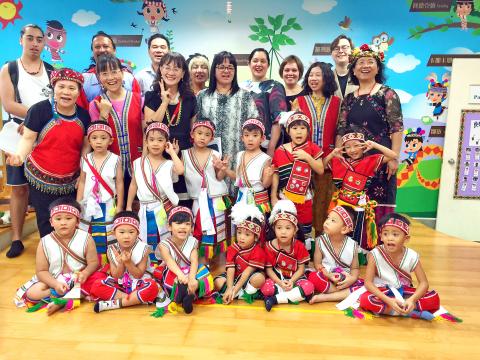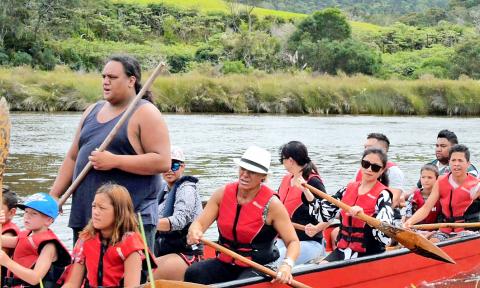The sound of the female elder’s call to the ancestors stirred deep emotion in Kararaina Cribb as she approached the Aboriginal Seediq community center in Nantou County last October.
“In Maori we call it the karanga call,” she says. “We greet our guests in the same way.”
As the chief executive of the Te Kohanga Reo National Trust, the non-governmental organization that has led New Zealand’s revival of the Maori language for more than three decades, Cribb made the trip to share their success story and offer pertinent lessons for Taiwan’s own movement to revive its Aboriginal languages.

Photo courtesy of Danfeng Elementary School
Currently, UNESCO lists five of Taiwan’s indigenous languages as critically endangered.
“Languages are lost around the world every day,” says Cribb. “But it doesn’t have to be that way here [in Taiwan].”
With the The Aboriginal Language Development Act (原住民族語言發展法) passing in May last year and coming into effect in January, Democratic Progressive Party Legislator Kolas Yotaka, a member of the Amis people who met with Cribb, says the next two years will be critical, and learning from the Maori example could be the difference between success and failure.

Photo courtesy of Office of Legislator Kolas Yotaka
“The Maori are our role model,” Kolas says.
‘LANGUAGE NEST’
Cribb says key to the success of Te Kohanga Reo’s program is the concept of “language nest,” in which a group of infants, like newborn chicks, are put in the care of native Maori-speaking community elders and raised in the mother tongue.

Photo courtesy of Office of Legislator Kolas Yotaka
Cribb says it is very important for elders to feel a sense of ownership of the language, which allows them to take pride in their role in bestowing it to the new generation.
Biung Takisvilainan, section chief of the language division at the Council of Indigenous Peoples (CIP), says language instructors for Taiwan’s program are also made up mostly of community elders who are certified after undergoing a 36 hours of training.
In New Zealand, community-run Kohanga Reo early education centers were established as the site for language nests.
After the first center was opened in April 1983, the next decade saw a rapid proliferation around the country, with a total of 800 centers caring for 14,000 children by the end of 1994.
These centers, Kolas says, is what Taiwan is missing.
Biung says that unfortunately conditions in most of Taiwan’s Aboriginal communities aren’t suitable for such centers as a high number of children live outside of their communities. Those that do remain, he adds, are mostly sent to kindergartens on weekdays and so that is where the language nest programs are currently being run.
“There are now 35 kindergartens and ten nurseries (教保中心) registered with the program,” he says.
Cribb also emphasizes the need for learning to go beyond the nest, so the language can be kept alive in the home.
Biung says to make sure this happens, the council has registered 300 family households with the program with numbers expected to increase over the coming year.
He adds that council officials visit the households monthly to evaluate progress made and offer any support or resources needed.
There is also a nanny program, where registered carers use the relevant mother tongue while looking after the children of an Aboriginal household during weekdays.
SCHOOLS OR TOMBS?
But even with the home front secure, setbacks are common once the children leave the nest and go to school.
Kolas says she has seen many examples of six year-old children who have learnt their mother tongue fluently at home only to lose their it within six months of beginning elementary school.
Cribb says that in New Zealand, after the initial batch of Kohanga Reo children reached elementary school age, Maori language education was introduced for all levels of New Zealand’s education system, including tertiary.
Kolas says Taiwan needs to do the same and introduce broader changes in the education system that will keep Aborignal language programs going throughout elementary school.
“Don’t let the schools become the tombs of our languages,” she says.
“They took our languages away,” she adds, recalling how she was punished for speaking her mother tongue as a student. “The time has come to return them.”
FROM REVIVE TO THRIVE
Cribb says the Maori have a lot to share with their Taiwanese cousins not only in the way they instill a sense of cultural belonging in their children through the use of their native language, but also in its latent economic potential.
“Our shared language and culture makes us who we are,” Cribb says, “but it can also be a source of economic value. We need to look at how our identity can be partnered to economic value and how it can move us forward.”
The New Zealand government estimates the Maori economy to be worth about US$30 billion and is a major force in the nation’s economy. The media industry especially has diversified and thrived since the revival of the language, with two major Maori TV channels, dozens of radio stations and growing online digital content.
Kolas, who used to work as a reporter for Taiwan Indigenous Television, says the media industry is a good place for Taiwan to start because Aboriginal-language content has more than just symbolic value, it can also create career pathways for young people to use their mother tongue.
“This will inspire the younger generations to learn as they can see where the language might take them one day,” she says.
The legislator has also put forward a proposal to partner Aboriginal children with elderly care centers, effectively coupling two of the current government’s initiatives, the Aboriginal Language Development act and long-term care services program. This move will not only raise efficiency, but also cut costs through combining budgets.
Right now, the CIP and the Ministry of Health and Welfare are discussing the creation of a new platform on which to base the proposal.
New Zealand’s revival of Maori has been a breakthrough success in no small part because it made the language applicable in the broader economy. If Taiwan hopes to mirror this model, language revival must not be the end in and of itself. Instead this program must act as a catalyst for broader changes that not only bring Aboriginal people prosperity and self-determination for their own communities, but also a greater role in contributing to the development of the nation itself.
“In Maori, we say that our language is our life force,” says Cribb.
“That’s exactly what our elders used to tell us,” says Kolas.
Bountiful South is a fortnightly column that covers Taiwan’s new cultural, diplomatic, business and tourism connections with its neighbors in the Indo-Pacific. Liam Gibson is a freelance reporter based in Taipei. He also researches regionalism as a postgraduate student at National Taiwan University’s Graduate Institute of National Development. You can reach him at liamtaipei@gmail.com

May 26 to June 1 When the Qing Dynasty first took control over many parts of Taiwan in 1684, it roughly continued the Kingdom of Tungning’s administrative borders (see below), setting up one prefecture and three counties. The actual area of control covered today’s Chiayi, Tainan and Kaohsiung. The administrative center was in Taiwan Prefecture, in today’s Tainan. But as Han settlement expanded and due to rebellions and other international incidents, the administrative units became more complex. By the time Taiwan became a province of the Qing in 1887, there were three prefectures, eleven counties, three subprefectures and one directly-administered prefecture, with

Taiwan Power Co (Taipower, 台電) and the New Taipei City Government in May last year agreed to allow the activation of a spent fuel storage facility for the Jinshan Nuclear Power Plant in Shihmen District (石門). The deal ended eleven years of legal wrangling. According to the Taipower announcement, the city government engaged in repeated delays, failing to approve water and soil conservation plans. Taipower said at the time that plans for another dry storage facility for the Guosheng Nuclear Power Plant in New Taipei City’s Wanli District (萬里) remained stuck in legal limbo. Later that year an agreement was reached

What does the Taiwan People’s Party (TPP) in the Huang Kuo-chang (黃國昌) era stand for? What sets it apart from their allies, the Chinese Nationalist Party (KMT)? With some shifts in tone and emphasis, the KMT’s stances have not changed significantly since the late 2000s and the era of former president Ma Ying-jeou (馬英九). The Democratic Progressive Party’s (DPP) current platform formed in the mid-2010s under the guidance of Tsai Ing-wen (蔡英文), and current President William Lai (賴清德) campaigned on continuity. Though their ideological stances may be a bit stale, they have the advantage of being broadly understood by the voters.

In a high-rise office building in Taipei’s government district, the primary agency for maintaining links to Thailand’s 108 Yunnan villages — which are home to a population of around 200,000 descendants of the Chinese Nationalist Party (KMT) armies stranded in Thailand following the Chinese Civil War — is the Overseas Community Affairs Council (OCAC). Established in China in 1926, the OCAC was born of a mandate to support Chinese education, culture and economic development in far flung Chinese diaspora communities, which, especially in southeast Asia, had underwritten the military insurgencies against the Qing Dynasty that led to the founding of